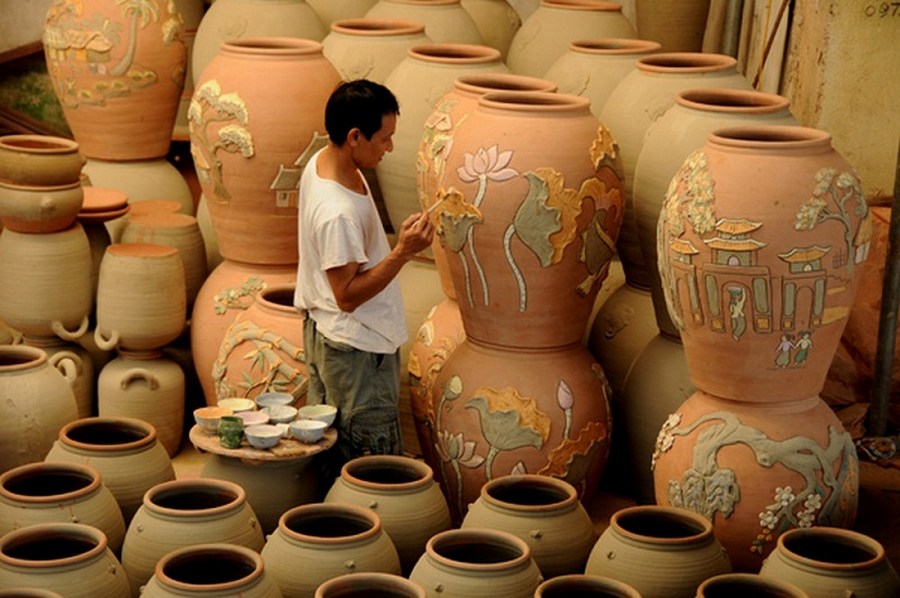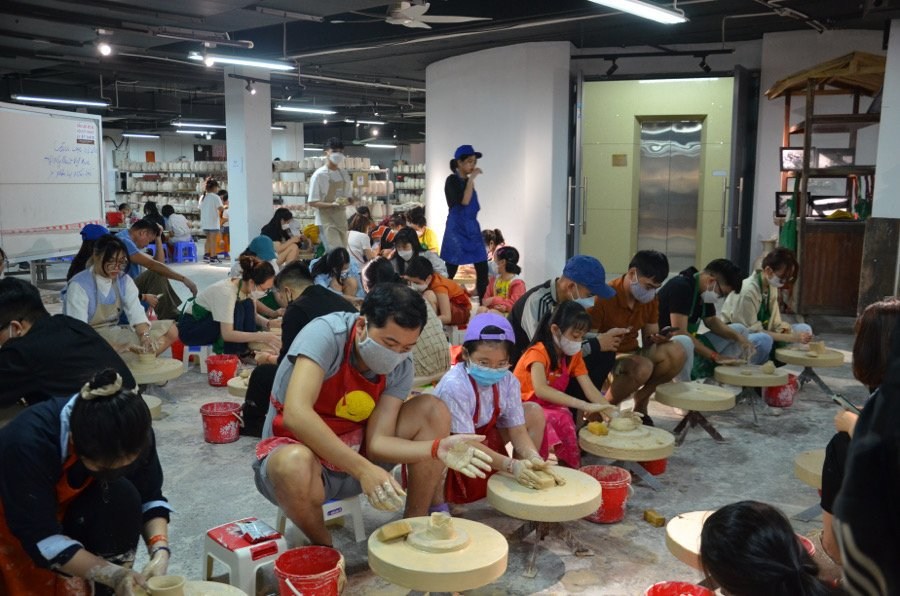Bat Trang Pottery Village is one of the oldest and most well-known traditional handicraft villages in Vietnam. The village is situated along the Red River, and its history can be traced back to the 14th century during the Ly Dynasty. Over the centuries, Bat Trang has developed into a hub of ceramic production, gaining recognition for its exquisite craftsmanship and unique artistry.

Address
Bat Trang village is situated about 13 kilometers southeast of Hanoi’s city center. The exact address is Bat Trang Commune, Gia Lam District, Hanoi, Vietnam.
You can use Google map to search the information about this place or ask local people to the Bat Trang commune.
Entrance fee
The good news is that there is no entrance fee to visit Bat Trang Pottery Village itself. You can freely walk around, explore the streets, and admire the scenery without any charge.
Costs within the village: However, there are costs associated with some activities and purchases within the village:
- Pottery workshops: These usually charge a fee for the session, ranging from 20,000 VND to 50,000 VND (around $1 – $3). This typically includes instruction, materials, and basic firing. Taking your creation home after firing usually incurs an additional fee of 35,000 – 50,000 VND (around $2 – $3).
- Bat Trang Pottery Museum: Entrance fee is 30,000 VND (around $1.5).
- Shopping: Prices for pottery items vary widely depending on size, craftsmanship, and complexity. You can find small souvenirs for as low as 20,000 VND (around $1) to larger decorative pieces costing millions of VND.
- Food and drinks: Prices at restaurants and cafes are similar to those in Hanoi city.
- Buffalo vehicle ride: Touring the village on a buffalo cart costs around 200,000 – 250,000 VND (around $10 – $13) for up to 10 people.
Tip: Keep in mind that these are estimated prices and may vary depending on the specific workshop, shop, or restaurant you visit. It’s always best to inquire beforehand to get the most accurate information.
History
Bat Trang Pottery Village, with origins dating back to the 14th century during the Ly Dynasty, has evolved into a renowned center for traditional ceramic craftsmanship. Initially recognized for brick and tile production, the village transitioned to pottery-making in the 15th century, becoming a hub of artistic innovation.
Throughout history, Bat Trang’s artisans have weathered wars and social changes, preserving the meticulous techniques and artistry of pottery-making. The village’s ceramics, adorned with intricate designs inspired by nature and mythology, hold both utilitarian and symbolic significance in Vietnamese culture.
In the colonial era, Bat Trang ceramics gained international acclaim, finding favor among European traders and collectors. Today, the village balances tradition with innovation, ensuring the continuity of its heritage. Recognized as a national intangible cultural heritage, Bat Trang invites visitors to witness a narrative that spans centuries, where history, art, and culture converge seamlessly.


Some facts about Bat Trang Pottery Village
- Traditional Techniques: The art of pottery-making in Bat Trang relies on traditional techniques passed down through generations. Hand-throwing, hand-painting, and wood firing are integral to the village’s commitment to preserving the authenticity of its craft.
- Cultural Recognition: Bat Trang Pottery Village holds the esteemed title of a national intangible cultural heritage of Vietnam. This official recognition underscores the village’s role in safeguarding and promoting the country’s cultural identity through its unique ceramic artistry.
- Global Impact: Beyond its local popularity, Bat Trang ceramics have achieved global recognition. Serving as an export hub, the village contributes significantly to Vietnam’s pottery industry, showcasing the universal appeal of its meticulously crafted creations.
- Annual Bat Trang Ceramic Festival: Celebrate the vibrancy of Bat Trang’s artistic community by attending the annual Bat Trang Ceramic Festival. This event attracts artists, craftsmen, and curious tourists, offering a dynamic showcase of the village’s diverse pottery traditions and cultural heritage.



Things to Do for Travelers
Workshop Tours
- Embark on a captivating journey through the numerous pottery workshops that line the streets of Bat Trang. Engage with skilled artisans who willingly share the secrets of their craft, offering insights into the various stages of ceramic production.
- Witness the mesmerizing process of shaping, decorating, and glazing pottery, gaining a deep appreciation for the meticulous craftsmanship that defines Bat Trang ceramics.

Hands-on Experience
- Immerse yourself in the world of pottery by participating in hands-on classes offered by local workshops. Under the guidance of expert potters, experience the joy of molding and creating your own unique pottery piece, carrying home a tangible memory of your visit.
Shopping
- Wander through the vibrant local markets and pottery shops, where an extensive array of ceramics awaits. From intricately designed plates and bowls to delicate tea sets and captivating decorative items, the market is a treasure trove for those seeking unique, handmade souvenirs.
- Engage in the age-old tradition of bargaining with local artisans, creating a memorable and interactive shopping experience.

Bat Trang Pagoda (But Thap Pagoda)
- Explore the historical and spiritual facets of Bat Trang by visiting the renowned But Thap Pagoda. Admire the ancient architecture adorned with intricate sculptures, gaining a deeper understanding of the cultural significance that permeates the village.

Culinary Exploration
- Indulge in the local culinary scene, where many eateries use Bat Trang pottery for serving traditional Vietnamese dishes. Delight in the unique dining experience, where the artistry of the ceramics complements the flavors of the cuisine.
Museum of Bat Trang Pottery
- Enhance your understanding of Bat Trang’s history by visiting the Bat Trang Pottery Museum. This repository of knowledge showcases a diverse collection of ancient and contemporary pottery, providing a comprehensive overview of the village’s artistic evolution.

Famous places around Bat Trang Pottery Village
- Ho Chi Minh’s Mausoleum: The final resting place of Vietnam’s founder, Ho Chi Minh.
- Bát Tràng Museum by National Artist Vũ Thắng: A museum dedicated to the work of Vietnamese ceramic artist Vũ Thắng.
- Bat Trang’s streets and lines: A beautiful and scenic area to walk around.

Visiting Bat Trang is not just a journey through time and artistry; it’s a comprehensive experience that allows travelers to immerse themselves in the fascinating history, artistic traditions, and daily life of a Vietnamese pottery village. Each encounter in Bat Trang unveils a new layer of the village’s rich tapestry, creating memories that linger long after the journey concludes.
